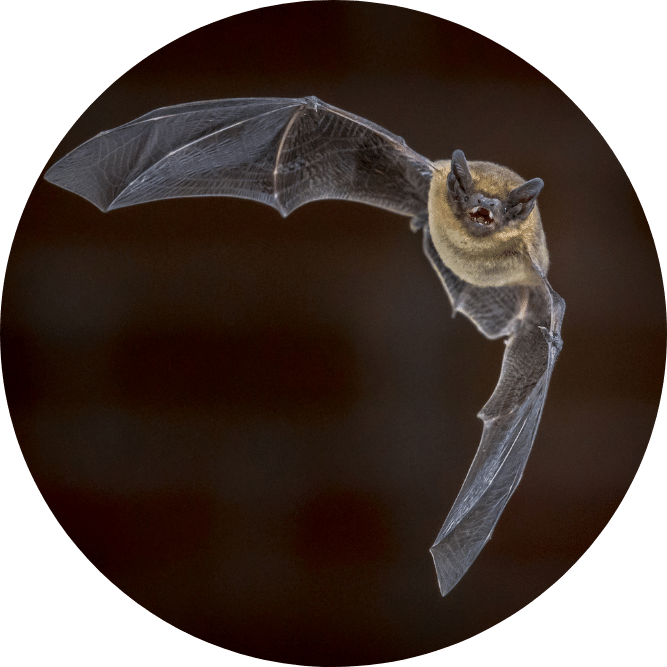Ultrasonic classifiers
Here you can find details on the unique capabilities of the Acoustic Pipeline’s ultrasonic classifiers for detecting and identifying bats and other species that produce high-frequency sound.
Features, capabilities and performance
The species identification algorithms in the BTO Acoustic Pipeline deliver unique and unrivalled performance for bats and other wildlife.
The Acoustic Pipeline’s ultrasonic classifiers give higher quality performance than many other systems:
- Identification of multiple species per file. The Pipeline classifiers don’t just focus on the species with the strongest signal. This means they can detect multiple simultaneous signals, including quieter species such as Barbastelle and Plecotus bats.
- Separate identification of bat echolocation calls, social calls and feeding buzzes.
- Identifying social calls can be useful for distinguishing some bat species, where the echolocation calls are very similar. Depending on the species, social calls can also provide useful information on the proximity to a roost, and / or mating behaviour.
- Identifying feeding buzzes may be useful for some bat species in providing quantitative information on feeding activity. Species identification based on feeding buzzes can also be useful for distinguishing some bat species, where the echolocation calls alone are very similar.
- Identification of small terrestrial mammals. This is valuable for identifying species of conservation interest like Hazel Dormouse, and avoids confusion between small terrestrial mammals and bat species with similar calls.
- Identification of bush-crickets. These may be of interest in their own right, or as a means to flag recordings that are only likely to include bush-crickets.
- Warnings to identify where species are rare or unexpected. Region-specific warnings facilitate checking of high-profile records and cases where confidence in the identification is low.
Accuracy
As long as good practice is followed when deploying bat detectors, classifier performance for most commonly occuring species is very high.
For example, for European bats, manual verification of over 86,000 independent recordings shows that the true positive rate is in the range of 93–100%.
Speed
Speed depends on the size of the task.
- The speed of upload depends on your broadband capacity.
- Once uploaded, the average processing time is 15 minutes per GB.
The Support Hub details the technical requirements for using Acoustic Pipeline ultrasonic classifiers.
Geographic coverage and species scope
The BTO Acoustic Pipeline’s ultrasonic classifiers cover Britain, Ireland and Europe.
We provide different classifiers for the countries and regions of Europe to reflect the different communities of bats and other species present across the continent. The Pipeline will automatically choose the right classifier for your recording location.
Collectively, the classifiers can identify all UK bat species and most European bat species. They also identify over 19 small terrestrial mammal species and over 25 bush-cricket species.
- Detailed list of bat, small terrestrial mammal and insect species coverage.
- Identification support for European bat species (PDF). This document provides detailed species-level identification information and may be useful when verifying identifications made by the Pipeline. Please drop us a line if you would like a higher resolution version of this pdf.
If you have ultrasonic recordings of species the classifier doesn’t currently cover please do get in touch – we are always keen to further extend our classifiers’ capabilities.
Quality assurance
The training data used to build the BTO Acoustic Pipeline ultrasonic classifiers comprise over 90,000 known species recordings.
These have been collected or collated by Stuart Newson from over a decade of working on the sound identification of bats as well as other species groups that are commonly recorded as ‘by-catch’ during bat surveys.
Stuart’s work has resulted in a number of resources that improve our understanding of species identification across a range of species groups, from bats, to bush-crickets and small mammals.
Pioneering work
This includes pioneering work on sound identification of small mammals in Britain and Ireland, which was published in British Wildlife.
- This work is covered in more detail in Stuart’s book, coauthored with Neil Middleton and Huma Pearce: Sound Identification of Terrestrial Mammals of Britain and Ireland, available from Pelagic Publishing.
Case studies and testimonials
Providing baseline data, improving data for planning decisions, and opportunities for citizen science: the BTO Acoustic Pipeline is used in a range of projects across the world.
- Read more about its use on our Case Studies page.
“The Acoustic Pipeline has allowed us to interpret huge amounts of data to gain some really interesting results on our local bat populations. It is the first time we have been able to gain this kind of data on a taxa throughout the whole Bailiwick.
The friendly user interface has made our citizen science project so much easier to coordinate and the almost instant interpretation has engaged the community with bats in a way we never expected.”
Emily Coule
Agriculture, Countryside and Land Management Services, States of Guernsey
Get in touch
Email us
Questions? We’d love to hear from you.
You can reach us at
acoustic.pipeline [at] bto.org












Share this page